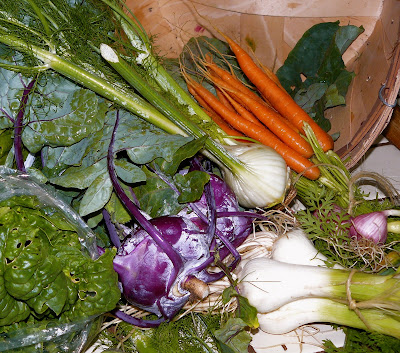 Here we are, in our fifth week of CSA booty and I will admit, I am falling a little behind. Two people can barely keep up with the bounty week in and week out of a Tecolote Farm basket. I am happy to share what we cannot reasonably use with my adult children and friends, but it still feels a little like admitting defeat not to be able to prepare and devour every delicious bite ourselves. We asked for it, we paid for it, we ought to be able to eat it, my reasoning goes.
Here we are, in our fifth week of CSA booty and I will admit, I am falling a little behind. Two people can barely keep up with the bounty week in and week out of a Tecolote Farm basket. I am happy to share what we cannot reasonably use with my adult children and friends, but it still feels a little like admitting defeat not to be able to prepare and devour every delicious bite ourselves. We asked for it, we paid for it, we ought to be able to eat it, my reasoning goes.Life gets in the way. As do Loquats. This bounty of fruit moving quickly from ripe to over-ripe in the backyard has been a powerfully distracting force recently. Once I have spent 3 hours in a steamy kitchen making a batch of jam, I am much less likely to have the time or energy to research, much less prepare, a new vegetable or three for our dinner.
The oak pollen counts are falling. This means I am able to go outside for longer and longer streches of time during this most beautiful time of year without collapsing afterwards into a swollen, sniffling headachey mess. My garden does require some attention here and there, but as gardens often do to gardeners, mostly my outside plants call to me to be noticed, admired, remarked upon and often, photographed.
 I have my own vegetables growing out back. I have tiny tomatoes, onions, tomatillos, at least a first bloom on the eggplant, zucchini vines stretching out, teensy carrots, and more. I cannot provide them anything other than water and admiration. Yet, this takes time.
I have my own vegetables growing out back. I have tiny tomatoes, onions, tomatillos, at least a first bloom on the eggplant, zucchini vines stretching out, teensy carrots, and more. I cannot provide them anything other than water and admiration. Yet, this takes time. On top of that, the two dinners I prepared on either side of that chicken pot roast marathon Sunday evening, did not use any of my gorgeous basket veggies. The chicken curry with loquat chutney at least used some loquats up. Dinner tonight however, other than providing a miniscule reduction in the amount of wonder salad mix on hand, was simply a departure from the tried and true to produce something I saw Mark Bittman prepare online and felt I wanted to try out for myself.

 Taco Filling with Poblano Strips and Potatoes (Tacos de Rajas con Papas) was one of those dinners where I was delighted and amazed with the results and my husband, while able to eat his dinner without complaint (he LOVED the salad), was not similarly impressed.
Taco Filling with Poblano Strips and Potatoes (Tacos de Rajas con Papas) was one of those dinners where I was delighted and amazed with the results and my husband, while able to eat his dinner without complaint (he LOVED the salad), was not similarly impressed. .....Next!!
.....Next!!So what do we have this week? Technologically savvy organic farmers sending the weekly newsletter via email to save paper for starters. Clothespins to clip to our returned baskets to help keep track of who brought theirs back and who did not, for a contrast. We have lettuce mix, radicchio, rainbow swiss chard, new onion, iceberg (hey - it's ORGANIC - don't be snide), kohlrabi, Red Ace and Pink Chioggia beets, turnips, carrots, and cilantro.
At least I know what to do with iceberg, turnips, an onion, the carrots and cilantro. The rest I'll figure out.
All by way of saying I have a full load of fresh vegetables in my house and a few left over from last week already on hand.
Ladies and gentlemen, I have a LOT of serious cooking to get done this week!
 But before I cooked, I had to preserve the gorgeous colors Mother Nature in concert with the Tecolote Farm folks has provided us this week. Looking at these works of art make me wish I was a painter. But then, these babies don't cry out only to be painted, they want to be EATEN. Onward.....
But before I cooked, I had to preserve the gorgeous colors Mother Nature in concert with the Tecolote Farm folks has provided us this week. Looking at these works of art make me wish I was a painter. But then, these babies don't cry out only to be painted, they want to be EATEN. Onward.....












































